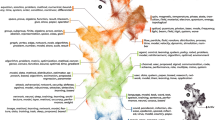Abstract
A cocitation analysis for thirty-six journals and other publications in neural networks research and related disciplines was conducted over three consecutive time periods spanning the years 1990-early 1997. Cluster analysis and MDS maps identified groupings representing foundation research areas (physics/optics, computer engineering, neuroscience, expert systems & cognition, and perception) along with neural networks and mathematical modeling of neural systems. Principal components analysis demonstrated a similar structure, with several journals and books loading on a majority of the factors. An INDSCAL analysis showed an increasing separation between natural sciences/psychology and engineering/neural networks research from the first time period to the third.
Similar content being viewed by others
Notes and references
Van Raan, A. F. J.;Tijssen, R. J. W. 1993. The neural net of neural networks research: An exercise in bibliometric mapping,Scientometrics, 26: 169–192.
Rappa, M. A.;Debakere, K. 1989. The Emergence of a New Technology: The Case of Neural Networks. WP#3031-89-BPS., Cambridge, MA: Sloan School of Management, Massachusetts Institute of Technology.
Rappa, M. A.;Debakere, K. 1990. International Survey of the Neural Network Research Community: Preliminary Report. WP#3170-90-BPS., Cambridge, MA: Sloan School of Management, Massachusetts Institute of Technology.
Cowan, J. D. 1990. Neural networks: The early days. In:Advances in Neural Information Processing Systems 2.,D. S. Touretzky (Ed.), San Mateo, CA: Morgan Kauffman. p. 828–842.
Hecht-Nielsen, R. 1990.Neurocomputing, Reading, MA: Addison-Wesley Publishing Co. See especially p. 14–19.
Simpson, P. K., 1990.Artificial Neural Systems: Foundations, Paradigms, Applications, and Implementations, New York, NY: Pergamon Press.
Allman, W. F. 1989.Apprentices of Wonder, New York, NY: Bantam Books.
Coveney, P.;Highfield, R. 1995.The Frontiers of Complexity, New York, NY: Fawcett Columbine.
Anderson, J. A.;Rosenfeld, E. 1988.Neurocomputing: Foundations of Research, Cambridge, MA: MIT Press.
Anderson, J. A.;Pellionisz, A.;Rosenfeld, E. 1990.Neurocomputing 2: Directions for Research Cambridge, MA: MIT Press.
McCain, K. W.;Whitney, J. P. 1994. Contrasting assessments of interdisciplinarity in emerging specialties: The case of neural netowrks research,Knowledge: Creation, Diffusion, Utilization, 15(3): 285–306.
Tijssen, R. J. W. 1993. A scientometric cognitive study of neural network research: Expert mental maps versus bibliometric maps,Scientometrics, 28:111–136.
Van Den Besselaar, P.;Leydesdorff, L. 1996. Mapping change in scientific specialties: A scientometric reconstruction of the development of artificial intelligence,Journal of the American Society for Information Science, 47(6): 415–436.
The fifth,International Journal of Neural Networks, has ceased publication.
Kohonen, T. 1989.Self-Organization and Associative Memory, New York, NY: Springer-Verlag.
Rumelhart, D. E.;McClelland, J. L. (Eds), 1986.Parallel Distributed Processing: Explorations in the Microstructure of Cognition, 2v, Cambridge, MA: MIT Press.
Hebb, D. O. 1949.The Organization of Behavior, New York, NY: John Wiley.
McCain, K. W. 1991. Mapping economics through the journal literature: An experiment in journal cocitation analysis,Journal of the American Society for Information Science, 42(4): 290–296.
McCain, K. W. 1990. Mapping authors in intellectual space: A technical overview,Journal of the American Society for Information Science, 41(6): 433–443.
One is reminded of the three “point-of-interest” models in the VIBE system that visualizes the distribution of documents as they relate to two or more specific topics. Both interactive and static literature visualization techniques, including bibliometric mapping, are discussed inWhite, H. D.;McCain, K. W. 1997. Visualization of literatures,Annual Review of Information Science & Technology, 32: 3–72; the VIBE system is explained clearly inOlsen, K. A.; Korfhage, R. R.; Sochats, K. M.; Spring, M. B.; Williams, J. G. 1993. Visualization of a document collection: The VIBE system,Information Processing & Management, 29(1): 69–81.
Rikken, F.;Kiers, H. A. L.;Vos, R. 1995. Mapping the dynamics of adverse drug-reactions in subsequent time periods using INDSCAL,Scientometrics, 33: 367–380.
White, H. D.; McCain, K. W. 1997. Visualizing a discipline: An author cocitation analysis of information science, 1972–1995,Journal of the American Society for Information Science (in press).
Coxon, A. P. M. 1982.The User's Guide to Multidimensional Scaling, Exeter, NH: Heinemann Educational Books Inc.
McCain, K. W. 1998. The Research Front Cluster History of Neural Networks Research, 1984–1991. in preparation.
Author information
Authors and Affiliations
Rights and permissions
About this article
Cite this article
McCain, K.W. Neural networks research in context: A longitudinal journal cocitation analysis of an emerging interdisciplinary field. Scientometrics 41, 389–410 (1998). https://doi.org/10.1007/BF02459053
Received:
Issue Date:
DOI: https://doi.org/10.1007/BF02459053




